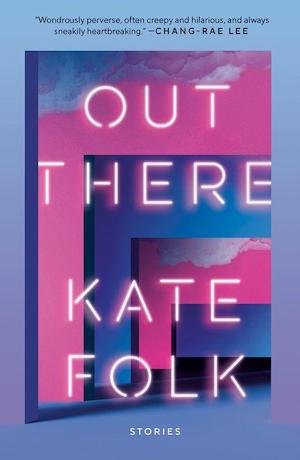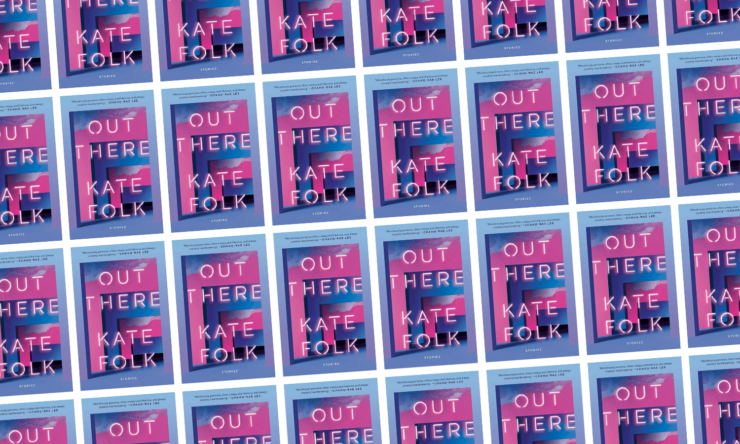Is it bad form to confess to finding a typo where none existed? Let me explain. In the opening story of Kate Folk’s new collection Out There—which is also the title story—the narrator recounts her frustration with online dating in a way that’s likely to resonate with anyone who’s spent time on The Apps. And then, something stood out.
“To further complicate matters,” the narrator states, “it was estimated that men on dating apps in the city were now 50 percent blots.” Blots? I thought. Shouldn’t that be bots? No, actually. That’s the gist of the story: in its near-future settings, a group of uncannily handsome artificial men known as blots have arrived on the scene. Their mission involves sleeping with women, stealing their personal data, and then evaporating into the æther.
Blots figure prominently in the title story, and they show up again in the book’s closing story, “Big Sur.” The two play out like fascinating riffs on similar themes, but from diametrically opposing perspectives. The narrator of “Out There” is fully aware of the presence of blots in her society, and is bound and determined to avoid them—which establishes a growing tension in terms of the men she encounters. If someone seems perfectly nice, is it a genuine human connection—or something much more insidious? For “Big Sur,” Folk ventures into the mind of a blot named Roger. And while this hews a little closer to the science fiction archetype of an artificial being who’s unaware of their origins, it still finds its own surreal energy, in part from the deadpan descriptions of the increasingly surreal behavior Roger and his cohorts engage in.
Buy the Book


Out There
There’s something of the comedy of manners to these stories, as well as others in the collection. But there’s also a bleaker undercurrent—these are, after all, stories about artificial beings effectively stalking women in order to steal their personal data for hackers. That’s creepy! And Folk is more than willing to venture to the more unsettling corners that some of these stories’ premises take her.
This is probably most prevalent in “Doe Eyes,” one of the handful of stories in the collection without an overtly speculative or fantastical element. Its narrator opens the story seeking to be shot in the woods by hunters in the hopes of dissuading them from future hunting trips. Gradually, that motivation ebbs away in favor of a morbid curiosity about what it might be like to be shot, albeit in a non-lethal way. There’s a bit of J.G. Ballard’s Crash here—that sense of profound alienation coupled with the threat of violence—and it culminates in an ending I haven’t been able to shake since I read it.
Elsewhere in the collection, Folk treats the reader to a host of surreal buildings. “Moist House” and “The House’s Beating Heart” both provide body horror-themed spins on the idea of a haunted house. Here, the haunting isn’t done by a ghost but instead is the result of aspects of a body in something that’s corporeal in a different sense of the word. “The Head in the Floor” is less outright horrific and more weird; you can probably guess what the premise is from its title.
Folk covers a lot of stylistic ground in this collection, but a few elements keep coming to the foreground. Intimate relationships and quiet betrayals, for one. Architecture is another—there’s also “A Scale Model of Gull Point,” about a vacationer trapped at the top of a resort tower. But there’s also something about routines and rituals that Folk returns to repeatedly. The blots’ interactions in “Big Sur” is one aspect of this; a family’s violent Thanksgiving traditions, in “The Turkey Rumble,” is another.
Like “Doe Eyes,” “The Turkey Rumble” features a kicker of a final sentence. That’s also true for “The Bone Ward,” about a medical facility dedicated to the care of a small group of people with a medical condition wherein their bones dissolve each night and reform each morning. That’s a compelling premise in and of itself, but the way that Folk describes the dynamics of a small group—with shifting allegiances and power struggles—turns what could feel twee into something thoroughly feral. It’s par for the course in this immersive, chilling debut.
Out There is published by Random House.
 Tobias Carroll is the managing editor of Vol.1 Brooklyn. He is the author of the short story collection Transitory (Civil Coping Mechanisms) and the novel Reel (Rare Bird Books).
Tobias Carroll is the managing editor of Vol.1 Brooklyn. He is the author of the short story collection Transitory (Civil Coping Mechanisms) and the novel Reel (Rare Bird Books).










